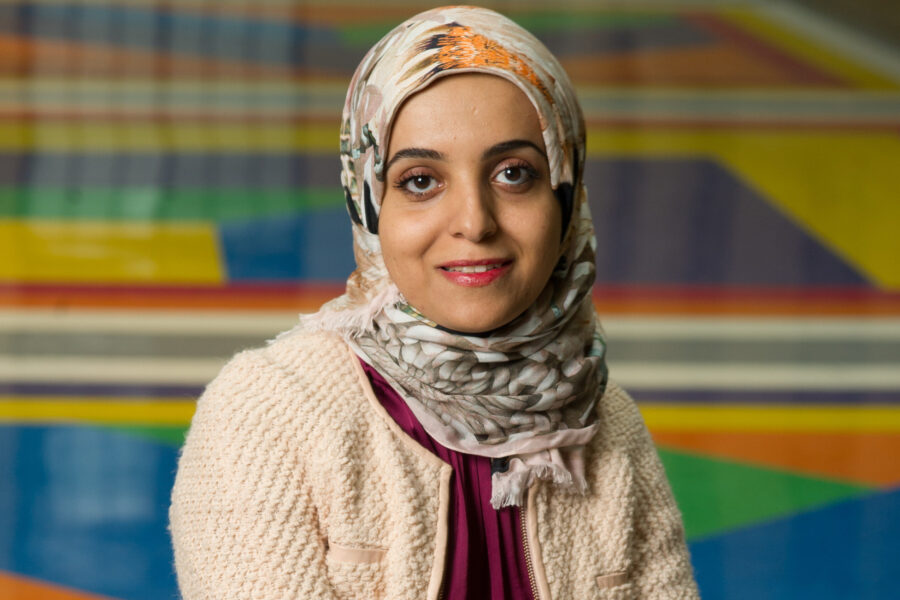Dr. Nabilah Abu-Ghazalah

Biography:
Dr. Abughazalah is an Associate Professor in pure mathematics (Algebra) at Princess Nourah bint Abdulrahman University (PNU) in Riyadh where she teaches calculus 1, calculus 2, foundations of mathematics, discrete mathematics and linear algebra in addition to graduation project supervision. Upon returning from the UK she served as the Director of the Scholarship Office at PNU before joining the Ibn Khaldun Fellowship program.
Her Master’s research was in Lie Algebra at King Khalid University, Abha, 2005. Her thesis research was on the homotopy classification of (n-1)- connected (3n+2)- dimensional free differential graded Lie algebra. She then completed her Phd in Pure Mathematics (Algebra) at the University of St-Andrews, UK, June 2013.
In her PhD at St Andrews she worked on Semigroup Theory. She began with classifications of semigroups which are decomposed into small number of copies of (semi)groups and then studied finiteness conditions as finite presentability, residual finiteness and decidability on disjoint unions of finitely many copies of the free monogenic semigroup, under the supervision of Prof. Nik Ruskuc. She was awarded the Academic Excellence Award from the Saudi Culture Bureau in London. Prior to joining MIT she had published four papers.
MIT Fellowship Research Abstract:
Dr. Abughazalah's research is in two directions:
a) Lower central series of semigroup and group algebras:
The goal of this project is to study the structure of the lower central series of semi- group and group algebras, along the lines of the previous papers. Let A be an associative algebra (over a commutative ring k). We define
L 1(A ) = A , L i (A ) = [A , L i− 1(A )],
and M i (A ) = AL i (A ), which equals AL i (A )A . And define
B i (A ) = L i (A )/L i +1(A ), N i (A ) = M i (A )/M i +1(A ).
Her goal is to study the structure of these spaces in the case when A is a semigroup (in particular, a group) algebra. Note that the case of the free algebra was already studied, although many questions remain unsolved. Consider the case when A is a semigroup algebra of a finitely generated semigroup with homogeneous relations. In this case A is a graded algebra, so all the above spaces are graded, and we can consider their Hilbert series. In particular, she is interested in the Hilbert series of B i and N i . For instance, it is shown in the paper by Jordan and Orem that the Hilbert series of N i is a rational function. She plans to take various specific semigroups and try to compute this function (e.g. for N 2, N 3) over various base fields, and study its properties. Also, she plans to do the same for B i (in this case, the rationality of the Hilbert series is an open question).
b) Finiteness conditions for semigroups:
Unlike classical algebraic structures, such as groups and rings, it is well known that a semigroup may decompose into a disjoint union of subsemigroups. For instance, every commutative semigroup is a disjoint union of archimedian com- mutative semigroups. And every Clifford semigroup is isomorphic to a strong semilattice of groups, and is thus a disjoint union of its maximal subgroups.
It is therefore natural to ask how properties of a semigroup S which can be decomposed into a disjoint union of subsemigroups S= T 1 ∪ T 2 ∪ . . . ∪ T n depend of properties of the T i .
In her project, she is going to study the properties of the semigroup which is disjoint unions of finitely many copies of the free monogenic semigroup
B = ( b ) = { b , b 2, . . .} .
In this semigroup S , we have that
S={a1, a2,...,a2, a22,...,an*an2,...}
where S is finitely generated by A = { a 1, a 2, . . . , a n } . The crucial properties for S are proved in previous papers, which says that S is finitely presented and residually finite.
Also, if S is the semigroup which is disjoint unions of exactly two or three copies of the free monogenic semigroup, then S has two or nine types of semigroups respectively, in which each type has a certain presentation.
She is continuing to study the finiteness conditions of such a semigroup and decidability (word problem and subsemigroup membership problem) for S in particular. Also is this semigroup Algebra a PI-Algebra?
Publications from MIT Research at ISI Journals
1. Nabilah Abughazalah and Pavel Etingof, "Linear growth for semigroups which are disjoint unions of finitely many copies of the free monogenic semigroup," Archiv der Mathematik, September 2015, Volume 105, Issue 3, pp 223-228. Published online first, August 20, 2015.
2. N. Abughazalah, P. Etingof, On properties of the lower central series of associative algebras. Journal of Algebra and Its Application. Published: 28 December 2015. Online, http://dx.doi.org/10.1142/S0219498816501875
3. N. Abughazalah, A concrete algorithm of word problem and subsemigroup problem for semigroups which are unions of finitely many copies of the free monogenic semigroup, to be published in Acta Mathematica Hungarica.
Additional Publications
1. N. Abughazalah, A CLASSIFICATION OF UNIONS OF THE FREE SEMIGROUP IN TWO GENERATORS IN THE IDEAL CASE, accepted in Mathematical reports , 2018.
Fellowship Sponsored By:
Saudi Aramco